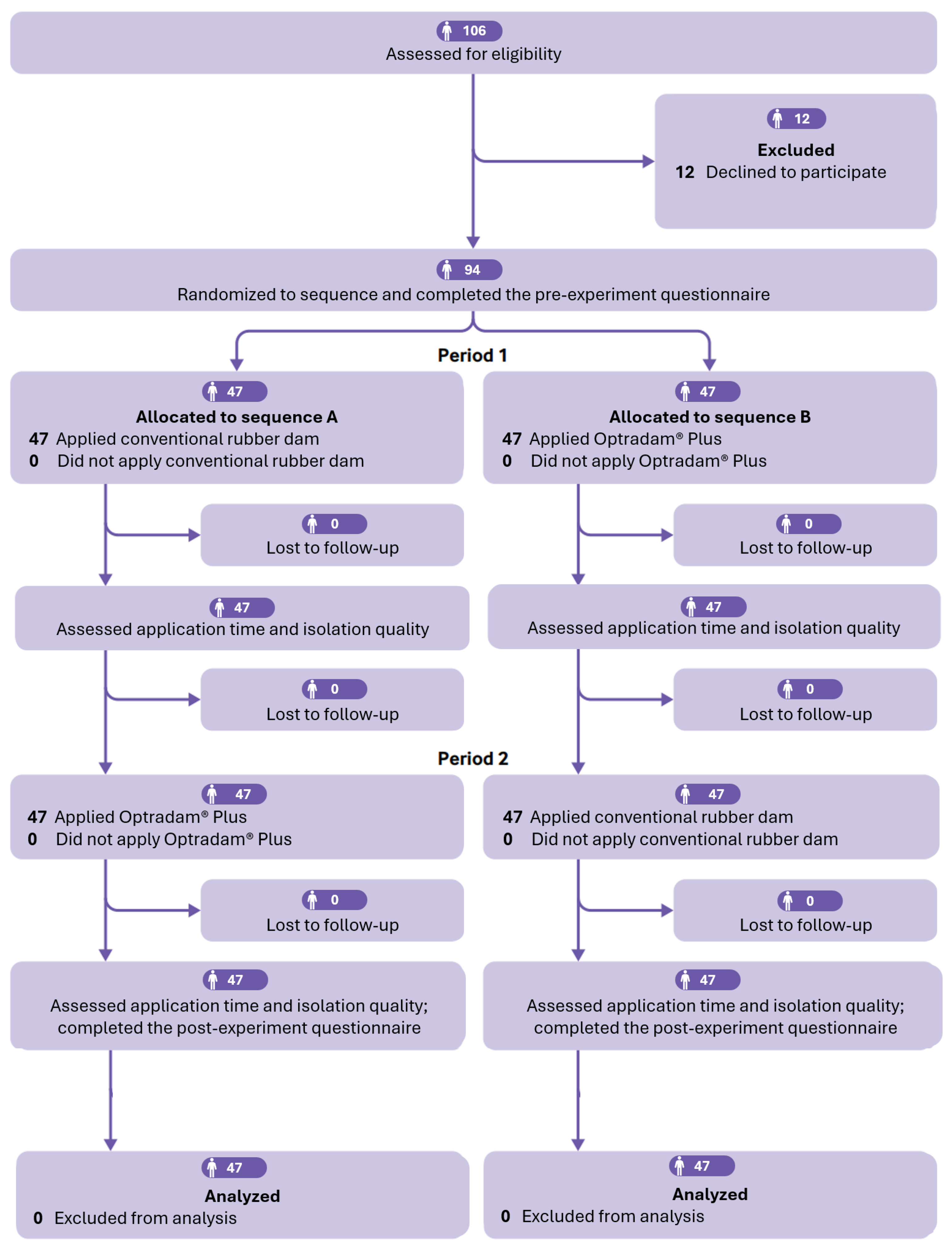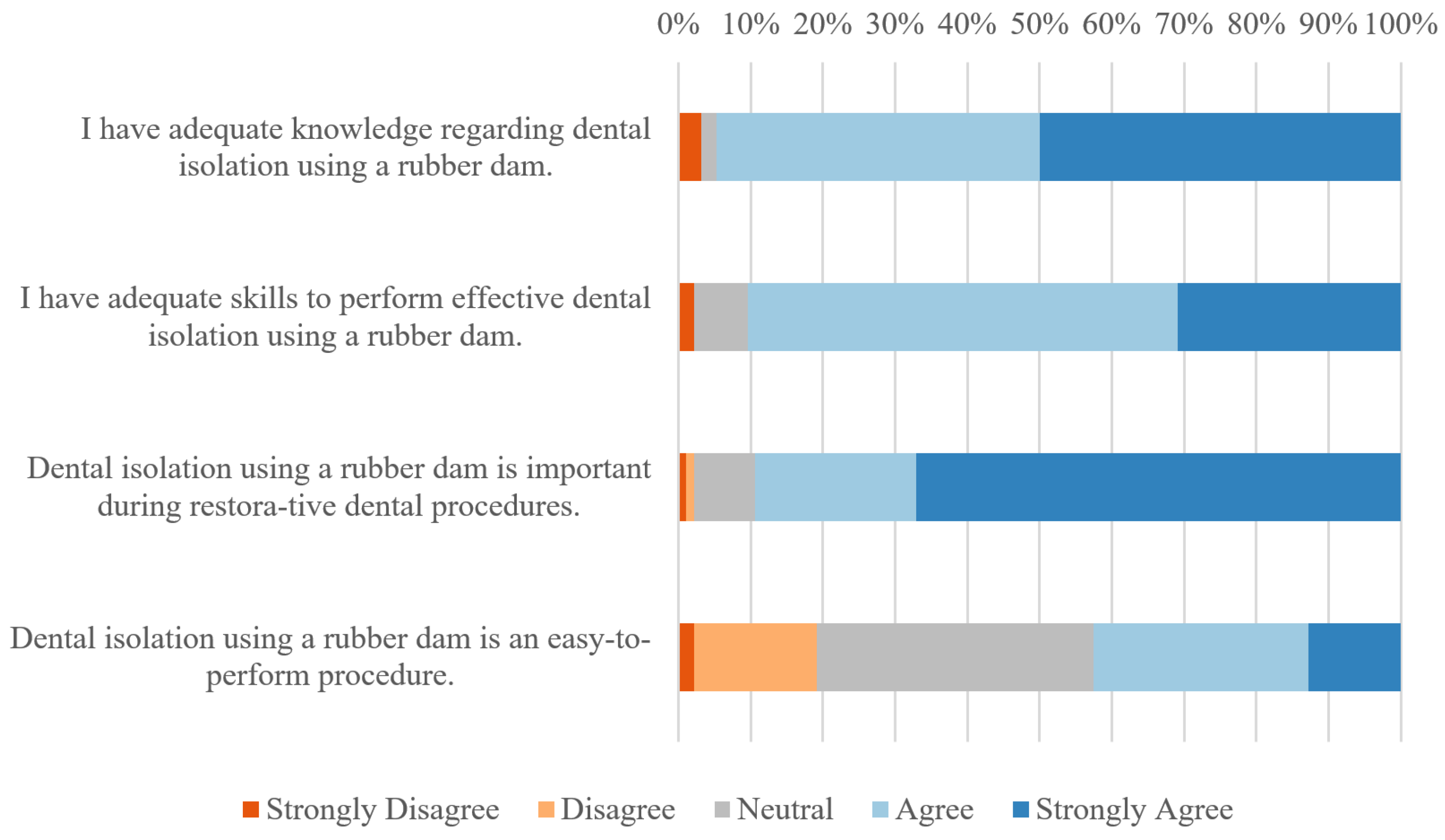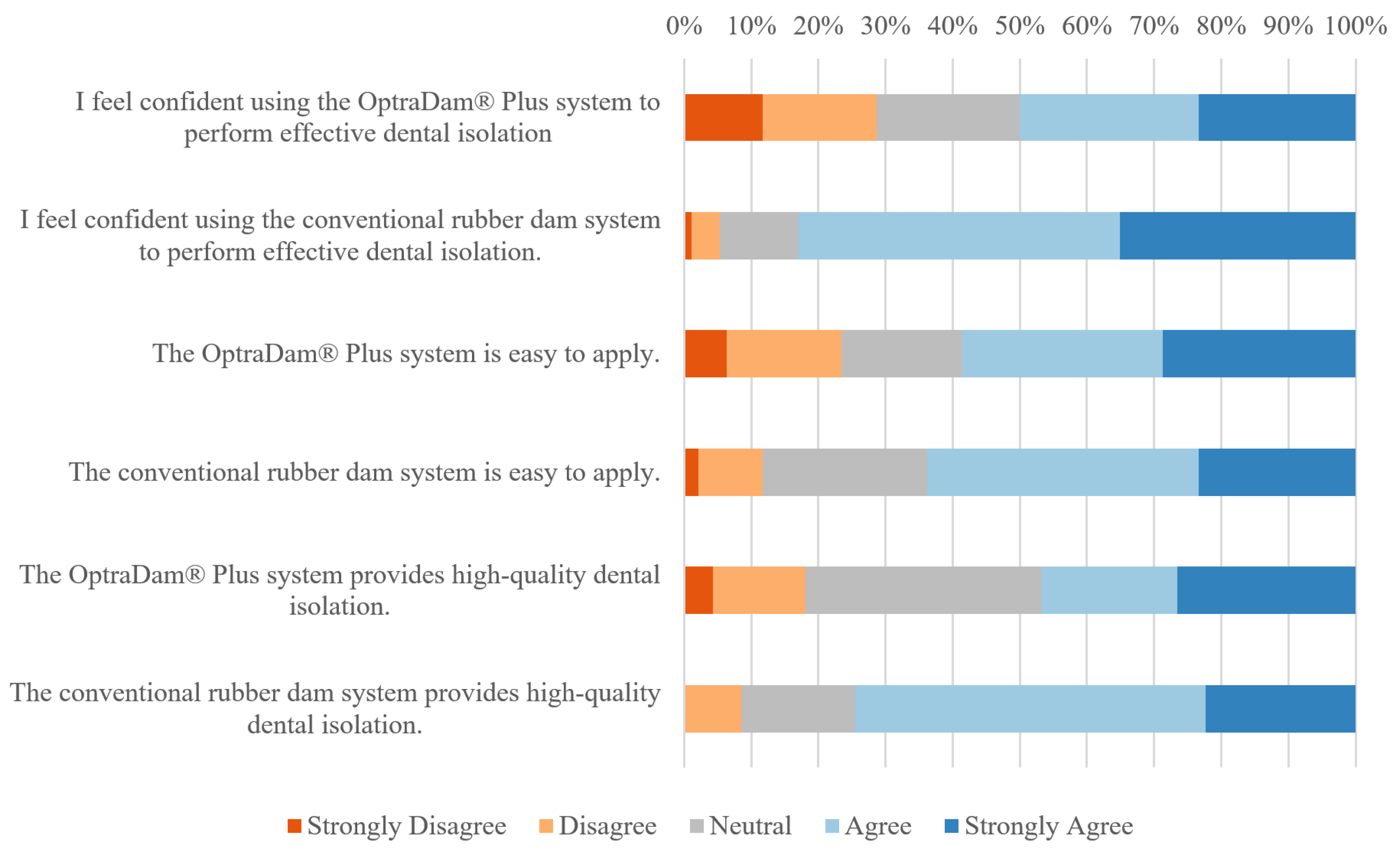Efficacy and Feasibility of OptraDam® Plus Versus Conventional Rubber Dams in Preclinical Simulation Training: A Randomized Crossover Trial
Abstract
1. Introduction
2. Materials and Methods
2.1. Trial Design
2.2. Sample Size
2.3. Participants
2.4. Randomization
2.5. Interventions
2.6. Ethical Considerations
2.7. Measured Outcomes
- The time taken for the placement of each rubber dam system by each participant, which was recorded in seconds by one of six calibrated examiners.
- The quality of isolation was assessed using the water retention ability method [13]. Following the placement of the rubber dam, one of the six calibrated examiners adjusted the lower occlusal plane to a 30-degree upward angle relative to a flat horizontal line. Then, a volume of 10 mL of water was introduced by the examiner into the isolated area with a syringe. After a period of 10 min, any residual water was aspirated back into the syringe and measured with an accuracy of ±0.5 mL. In instances where there was complete water leakage through the rubber dam, the time of occurrence was documented in seconds. The quality of isolation was evaluated based on the ordinal scale in Table 1.
- Participating students’ general perceptions and views regarding rubber dam isolation were evaluated using the first part of a paper-based questionnaire administered before the experiment, and their perceptions and views of the two tested systems were evaluated using the second part administered after the experiment (Appendix A). The questionnaire was adapted from two previously validated questionnaires [9,16]. Its face validity was evaluated by three independent faculty members in the Department of Restorative and Prosthetic Dental Sciences at the College of Dentistry, KSAU-HS.
2.8. Statistical Analysis
3. Results
3.1. Application Time
3.2. Isolation Quality
3.3. Pre-Experiment Perceptions
3.4. Post-Experiment Perceptions
4. Discussion
5. Conclusions
Supplementary Materials
Author Contributions
Funding
Institutional Review Board Statement
Informed Consent Statement
Data Availability Statement
Acknowledgments
Conflicts of Interest
Abbreviations
| IRB | Institutional Review Board |
| IQRs | Interquartile ranges |
| KAIMRC | King Abdullah International Medical Research Center |
| KSAU-HS | King Saud bin Abdulaziz University for Health Sciences |
Appendix A
- Pre-experiment questionnaire
- I have adequate knowledge regarding dental isolation using a rubber dam.
- Strongly Disagree
- Disagree
- Neutral
- Agree
- Strongly Agree
- I have adequate skills to perform effective dental isolation using a rubber dam.
- Strongly Disagree
- Disagree
- Neutral
- Agree
- Strongly Agree
- Dental isolation using a rubber dam is important during restorative dental procedures.
- Strongly Disagree
- Disagree
- Neutral
- Agree
- Strongly Agree
- Dental isolation using a rubber dam is an easy-to-perform procedure.
- Strongly Disagree
- Disagree
- Neutral
- Agree
- Strongly Agree
- Post-experiment questionnaire
- The OptraDam® Plus system is easy to apply.
- Strongly Disagree
- Disagree
- Neutral
- Agree
- Strongly Agree
- The conventional rubber dam system is easy to apply.
- Strongly Disagree
- Disagree
- Neutral
- Agree
- Strongly Agree
- I feel confident using the OptraDam® Plus system to perform effective dental isolation.
- Strongly Disagree
- Disagree
- Neutral
- Agree
- Strongly Agree
- I feel confident using the conventional rubber dam system to perform effective dental isolation.
- Strongly Disagree
- Disagree
- Neutral
- Agree
- Strongly Agree
- The OptraDam® Plus system provides high-quality dental isolation.
- Strongly Disagree
- Disagree
- Neutral
- Agree
- Strongly Agree
- The conventional rubber dam system provides high-quality dental isolation.
- Strongly Disagree
- Disagree
- Neutral
- Agree
- Strongly Agree
References
- Ahmad, I.A. Rubber dam usage for endodontic treatment: A review. Int. Endod. J. 2009, 42, 963–972. [Google Scholar] [CrossRef]
- Goldfein, J.; Speirs, C.; Finkelman, M.; Amato, R. Rubber dam use during post placement influences the success of root canal-treated teeth. J. Endod. 2013, 39, 1481–1484. [Google Scholar] [CrossRef] [PubMed]
- Kuo, S.C.; Chen, Y.L. Accidental swallowing of an endodontic file. Int. Endod. J. 2008, 41, 617–622. [Google Scholar] [CrossRef] [PubMed]
- Dev, A.K.; Gupta, A.; Dalai, S. A Comparative Investigation of Aerosol Generation and Exposure Risk During Access Cavity Preparation with or Without Rubber Dam Application. Cureus 2024, 16, e61758. [Google Scholar] [CrossRef] [PubMed]
- Alqahtani, S.M.; Chaturvedi, S.; Alshahrani, A.A.; Alqahtani, A.M.; Almzher, A.A.; Alqhtani, R.A.; Alqhtani, B.A.; Alfaifi, H.Q.; Alshehri, N.M.; Al Moaleem, M.M. Online Questionnaire-Based Study to Evaluate the Attitudes and Use of Rubber Dental Dams by Saudi Dental Practitioners. Med. Sci. Monit. 2023, 29, e938672. [Google Scholar] [CrossRef]
- Gilbert, G.H.; Litaker, M.S.; Pihlstrom, D.J.; Amundson, C.W.; Gordan, V.V. Rubber dam use during routine operative dentistry procedures: Findings from the dental PBRN. Tex. Dent. J. 2013, 130, 337–347. [Google Scholar] [CrossRef]
- Abuzenada, B.M. Attitude of Dental Students towards the Rubber Dam Use in Operative Dentistry. J. Pharm. Bioallied Sci. 2021, 13, S637–S641. [Google Scholar] [CrossRef]
- Al-Sabri, F.A.; Elmarakby, A.M.; Hassan, A.M. Attitude and knowledge of isolation in operative field among undergraduate dental students. Eur. J. Dent. 2017, 11, 83–88. [Google Scholar] [CrossRef]
- Mala, S.; Lynch, C.D.; Burke, F.M.; Dummer, P.M. Attitudes of final year dental students to the use of rubber dam. Int. Endod. J. 2009, 42, 632–638. [Google Scholar] [CrossRef]
- Ballal, N.V.; Khandelwal, D.; Saraswathi, M.V. Rubber dam in endodontics: An overview of recent advances. Int. J. Clin. Dent. 2013, 6, 319–330. [Google Scholar]
- Ivoclar Vivadent, AG. OptraDam® and OptraGate®; brochure; Ivoclar Vivadent AG: Schaan, Liechtenstein, 2005. [Google Scholar]
- Ivoclar Vivadent, AG. OptraDam Plus, For absolute Isolation. Available online: https://www.ivoclar.com/en_li/products/accessories/optradam (accessed on 14 May 2025).
- Kapitán, M.; Sustova, Z.; Ivancakova, R.; Suchanek, J. A comparison of different rubber dam systems on a dental simulator. Acta Medica 2014, 57, 15–20. [Google Scholar] [CrossRef]
- Kapitán, M.; Suchánková Kleplová, T.; Suchánek, J. A Comparison of Three Rubber Dam Systems In Vivo—A Preliminary Study. Acta Medica 2015, 58, 15–20. [Google Scholar] [CrossRef] [PubMed]
- Joshi, P.; Walimbe, D.; Mandke, L. A Comparison of Conventional and New Rubber Dam Systems in Dental Practice. Bhavnagar Univ. J. Dent. 2016, 6, 11–21. [Google Scholar]
- Bailey, O.; Shand, B.; Ellis, I. Class II composite restoration technique teaching: A randomised controlled crossover laboratory-based trial involving a novel ringless sectional matrix technique. Eur. J. Dent. Educ. 2023, 27, 963–973. [Google Scholar] [CrossRef] [PubMed]
- Dwan, K.; Li, T.; Altman, D.G.; Elbourne, D. CONSORT 2010 statement: Extension to randomised crossover trials. BMJ 2019, 366, l4378. [Google Scholar] [CrossRef]
- Waheed, A.; Khokhar, S.A.; Sarwar, N.; Asif, S.; Shar, M.K. Comparison of functional outcomes of two different rubber dam systems in dental practices. Biomedica 2024, 40, 50–54. [Google Scholar] [CrossRef]
- Allen, M. Errors of measurement: Ceiling and floor effects. Sage Encycl. Commun. Res. Methods 2017, 4, 434–435. [Google Scholar] [CrossRef]
- Contemporary Product Solutions. Ivoclar Vivadent’s OptraDam Plus—Dental Products Report. Available online: https://www.dentalproductsreport.com/view/ivoclar-vivadents-optradam-plus (accessed on 29 June 2025).
- Tanalp, J.; Kayataş, M.; Can, E.D.; Kayahan, M.B.; Timur, T. Evaluation of senior dental students’ general attitude towards the use of rubber dam: A survey among two dental schools. ScientificWorldJournal 2014, 2014, 290101. [Google Scholar] [CrossRef]
- Ryan, W.; O’Connel, A. The attitudes of undergraduate dental students to the use of the rubber dam. J. Ir. Dent. Assoc. 2007, 53, 87–91. [Google Scholar]
- Majid, O.W. Assessment of clinical ability in the removal of teeth among undergraduate dental students: A longitudinal comparative study. Br. J. Oral. Maxillofac. Surg. 2018, 56, 870–876. [Google Scholar] [CrossRef]
- Bokhari, A.M.; Vinothkumar, T.S.; Albar, N.; Basheer, S.N.; Felsypremila, G.; Khayat, W.F.; Zidane, B.; Apathsakayan, R. Barriers in Rubber Dam Isolation Behaviour of Dental Students During Adhesive Restorative Treatments: A Cross-Sectional Study. Cureus 2024, 16, e58329. [Google Scholar] [CrossRef] [PubMed]
- Kruger, J.; Dunning, D. Unskilled and unaware of it: How difficulties in recognizing one’s own incompetence lead to inflated self-assessments. J. Pers. Soc. Psychol. 1999, 77, 1121–1134. [Google Scholar] [CrossRef] [PubMed]
- McIntosh, R.D.; Fowler, E.A.; Lyu, T.; Della Sala, S. Wise up: Clarifying the role of metacognition in the Dunning-Kruger effect. J. Exp. Psychol. Gen. 2019, 148, 1882–1897. [Google Scholar] [CrossRef] [PubMed]
- Crowne, D.P.; Marlowe, D. A new scale of social desirability independent of psychopathology. J. Consult. Psychol. 1960, 24, 349–354. [Google Scholar] [CrossRef]
- Feierabend, S.; Matt, J.; Klaiber, B. A comparison of conventional and new rubber dam systems in dental practice. Oper. Dent. 2011, 36, 243–250. [Google Scholar] [CrossRef]
- Kruse, C.; Schlafer, S.; Pedersen, K. A comparison of video-based and slide-based teaching before hands-on rubber dam application: A quantitative and qualitative study. J. Dent. Educ. 2022, 86, 334–342. [Google Scholar] [CrossRef]
- Li, L.; Lian, X.; Chen, Y.; Peng, W.; Dai, Y.; Zou, H. The application of a virtual rubber dam isolation training system in dental preclinical education. Heliyon 2024, 10, e34728. [Google Scholar] [CrossRef]




| Score | Definition |
|---|---|
| 0 | Major failure of the rubber dam, resulting in immediate full water leakage. |
| 1 | Complete water leakage occurs within 5 min. |
| 2 | Complete water leakage occurs between 5 and 10 min. |
| 3 | After 10 min, retains ≤5 mL of the 10 mL water volume. |
| 4 | After 10 min, retains >5 mL but <10 mL of the water volume |
| 5 | After 10 min, retains all 10 mL of the water volume. |
| No. | Items | Median (IQR) 1 |
|---|---|---|
| 1 | I have adequate knowledge regarding dental isolation using a rubber dam. | 4.5 (4.0–5.0) |
| 2 | I have adequate skills to perform effective dental isolation using a rubber dam. | 4.0 (4.0–5.0) |
| 3 | Dental isolation using a rubber dam is important during restorative dental procedures. | 5.0 (4.0–5.0) |
| 4 | Dental isolation using a rubber dam is an easy-to-perform procedure. | 3.0 (3.0–4.0) |
| Variable | OptraDam® Plus Median (IQR) | Conventional Median (IQR) | Wilcoxon V | p-Value |
|---|---|---|---|---|
| I feel confident using this system. | 3.5 (2.0–4.00) | 4.0 (4.0–5.0) | 385 | <0.001 * |
| This system is easy to apply. | 4.0 (3.0–5.0) | 4.0 (3.0–4.0) | 1269 | 0.306 |
| This system provides high-quality dental isolation | 3.0 (3.0–5.0) | 4.0 (3.5–4.0) | 661 | 0.009 * |
Disclaimer/Publisher’s Note: The statements, opinions and data contained in all publications are solely those of the individual author(s) and contributor(s) and not of MDPI and/or the editor(s). MDPI and/or the editor(s) disclaim responsibility for any injury to people or property resulting from any ideas, methods, instructions or products referred to in the content. |
© 2025 by the authors. Licensee MDPI, Basel, Switzerland. This article is an open access article distributed under the terms and conditions of the Creative Commons Attribution (CC BY) license (https://creativecommons.org/licenses/by/4.0/).
Share and Cite
BaHammam, F.; Alsuhaibani, M.; Almutairi, F.; Aldakhil, S.; Albarrak, S.; Alreshaid, L.; Farook, F. Efficacy and Feasibility of OptraDam® Plus Versus Conventional Rubber Dams in Preclinical Simulation Training: A Randomized Crossover Trial. Dent. J. 2025, 13, 485. https://doi.org/10.3390/dj13110485
BaHammam F, Alsuhaibani M, Almutairi F, Aldakhil S, Albarrak S, Alreshaid L, Farook F. Efficacy and Feasibility of OptraDam® Plus Versus Conventional Rubber Dams in Preclinical Simulation Training: A Randomized Crossover Trial. Dentistry Journal. 2025; 13(11):485. https://doi.org/10.3390/dj13110485
Chicago/Turabian StyleBaHammam, Fahad, Mohammed Alsuhaibani, Faisal Almutairi, Sultan Aldakhil, Shug Albarrak, Lulwah Alreshaid, and Fathima Farook. 2025. "Efficacy and Feasibility of OptraDam® Plus Versus Conventional Rubber Dams in Preclinical Simulation Training: A Randomized Crossover Trial" Dentistry Journal 13, no. 11: 485. https://doi.org/10.3390/dj13110485
APA StyleBaHammam, F., Alsuhaibani, M., Almutairi, F., Aldakhil, S., Albarrak, S., Alreshaid, L., & Farook, F. (2025). Efficacy and Feasibility of OptraDam® Plus Versus Conventional Rubber Dams in Preclinical Simulation Training: A Randomized Crossover Trial. Dentistry Journal, 13(11), 485. https://doi.org/10.3390/dj13110485







